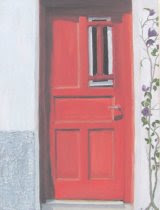
It was so much fun to walk through the old town of Naxos and take photos. The effects of history and nature are readily apparent.
There are the remnants of the conquerors: sea-etched marbles of Roman temples, rubble of Venetian castles with rusty brass door knockers, and deteriorating monasteries as remembrances of the Crusades

The town set high on a hill and faces out to sea, evidence of vigilance, allowing time to alert islanders of approaching sieges from pirates or conquerors. The streets are narrow, winding and twisting with low arches –- a labyrinth designed to slow armed advancements. Doorways are narrow and low – the better to defend one’s home.
Nature also exacts a price for its gifts

 of sun and sea life. Battering storms, wind, and salty breezes make all things metal rust. Paint flakes off. Plaster peels, revealing stones.
of sun and sea life. Battering storms, wind, and salty breezes make all things metal rust. Paint flakes off. Plaster peels, revealing stones.Vigilance of another sort, therefore, is required to maintain man-made structures.
Even new, white, angular buildings etched against azure skies eventually submit to sun, storms and the sea’s salt.
I took over 500 photos and will create a series of 30-35 in oil on canvas in keeping with classicism. My wordsmith friend and I arrived at a title for the series: “Access: Greek Isles,” including vignettes of the history and nature of life on the islands are shown through the portals of entry….doors, windows, streets, and gates.
Three more are in various stages of completion and I'll post them as soon as they're ready. This way, you can walk with me through the town and see what I saw. (Please go to http://www.r-atencio.com/gallery/access_greece/access_greece.html to see enlargements. I rushed to get the doors up for you to see. None of the others are ready yet. )











